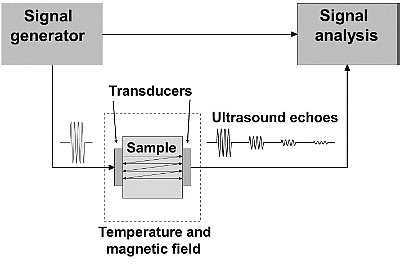Ultrasonic Measurments.
| FEATURES | TOULOUSE | DRESDEN | GRENOBLE |
|---|---|---|---|
| Local Contact | Cyril Proust |
Sergei Zherlitsyn |
David Le Boeuf |
| Description | The sound velocity and attenuation are measured using a pulse-echo method with a phase-sensitive detection technique which is available both in DC and pulsed field.
 |
||
| Ultrasound frequency | 5 - 900 MHz | ||
| Field range | 0 ... 90 T | 0 ... 90 T | 0 ... 36 T |
| Temperature range | 0.5 – 300 K | 0.02 – 300 K | 325 to 0.05 K |
| Sample size | Typically, 1 mm length, in the direction of sound propagation | Typically sizes 0.6 - 5 mm The samples can be mounted with a defined orientation | typically 1mm length, in the direction of ultrasound propagation |
| Sensitivity | ~10-5 for the relative change of sound velocity in pulsed field | The resolution for the relative sound-velocity change is 10⁻⁶ and 10⁻³ for the sound attenuation | Depends a lot on the echo pattern: 1 ppm in sound velocity change in the best conditions. |
| Typical experiment | Field sweeps at fixed temperature | Sound velocity versus magnetic field in the frustrated antiferromagnet CdCr2O4.

|
Both temperature sweeps and field sweeps are possible. |
| Sample Holder | Please, contact the local contacts. | The sample holder is a simple plate with thermometer connected to it. The probe is equipped with two low attenuation coax cables, allowing to perform reflection or transmission experiments. Specific sample mounting can be achieved if required. | |
| Sample environment | Gaseous helium from 300 K down to 4 K, liquid helium down to 1.4 K (0.5 K for 3He) | Gaseous helium from 300 K down to 4 K, liquid helium down to 1.3 K | VTI environment between 325 and 1.2 K. For lower temperatures,3He and dilution refrigerator can be used. |
| Examples | In pulsed fields : D. LeBoeuf et al., Physics 9, 79 (2013). F. Laliberté et al., Quantum Materials 3, 11 (2018) In zero field : S. Benhabib at al., Nature Physics 17, 194 (2021). |
S. Zherlitsyn et al., Low Temp. Phys. 40, 123 (2014) Z. Wang et al., Phys. Rev. Let. 120, 207205 (2018) V. Tsurkan et al., Science Advances 3, e1601982 (2017) S. Zherlitsyn et al., Phys. Rev. B 91, 060406(R) (2015) |
The ultrasound technique is highly sensitive to phase transitions in high magnetic field. The technique is available both in DC and pulsed field. Below are examples where the technique is used to detect and characterize field induced phase transitions in different systems.
Superconductors: npj Quantum Materials 3, 11 (2018) Semi-metals: Nat. Comm. 8 1337 (2017) |

